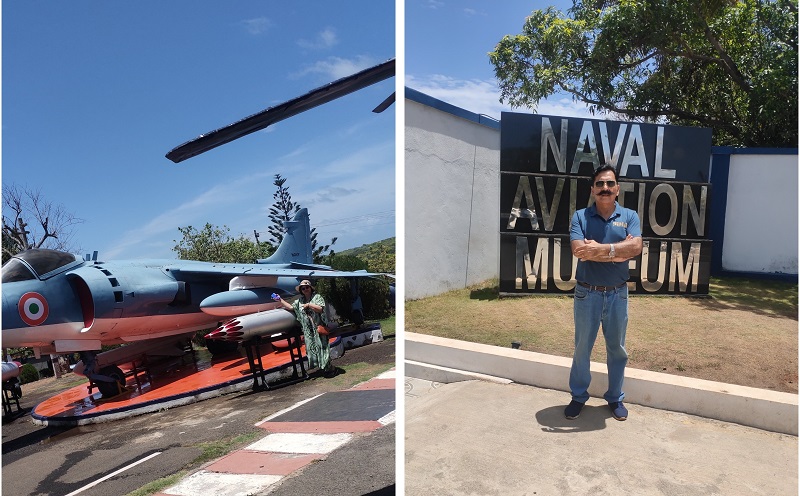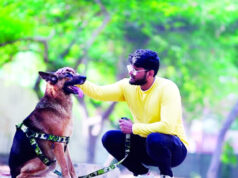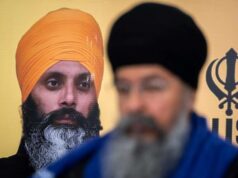Naval Aviation Museum, Goa: Repository of Country’s Oceanic Valour
‘When everything seems to be going against you, remember that the aircraft takes off against the wind and not with it’—Henry Ford

By Colonel Satish Singh Lalotra
Armed forces are the true binders of the geographical entity that goes by the name of a nation –state, be its physical expanse or the inhabitants by the sheer power of the quality of its tenets of selfless service, sacrifice and the spirit of carriers of nationhood. But then what binds the armed forces within itself? It’s the timelessness of the so called ‘Naam, Namak & Nishan’ as known in our country that acts as the binding factor to keep all the elements of the armed forces rooting for their ‘Raison De etre’. Without the above mentioned facets, it is difficult to envision a body of troops from the smallest entity to the largest one to hold cohesion amongst its ranks. Museums dedicated to the armed forces are one such facet which are facilitators for the maintenance of such cohesion not only in this disciplined force but also amongst the civil populace of a country.
Indian Navy (IN) the youngest and smallest of the component of the armed forces of our country despite its relatively young age has been able to script a tale of valour spread from the shores of India to deep seas of Indian ocean, Arabian sea, the bay of Bengal all the way to Wular and Dal lake with all the might at its command. Situated at ‘Bogmalo’ 6 kilometers from ‘ Vasco da Gama’in Goa, India focused on the history of the Indian naval arm decades back in 1998. Few months back I had gone on a brief sojourn to Goa and its surreal surroundings with my better half since her school had summer vacations. Though we had not made any professional itinerary for seeing this scenic place, except for fitting prominent places of interest and importance of national and international repute in and around Goa; both of us came much wiser after the visit tinged by an act of serendipity since one place of interest had cross linkages with another close by leading us to that place too eventually.
Based near Benaulim beach in south Goa for this entire trip duration, we had to travel Bogmalo the site for Naval aviation museum which is diametrically opposite in northerly direction at a distance of about 26 kilometers following NH-43 and passing through areas such as Dabolim and Cavelossim .Taking about 45 odd minutes to reach Bogmalo from our camping site the duo of us entered the Naval aviation museum through a security gate after having paid an entry fees of Rs 100/. Inside the museum the area is divided into two parts an outdoor exhibit and a two storey indoor gallery. Museum has an impressive grey coloured display board at its entrance with words written as –NAVAL AVIATION MUSEUM in broad capital letters made of stainless steel. The museum’s entry is awesome with a display of Indian navy’s once largest aircraft ‘Lockheed L-1049 Super constellation’ a member of the Lockheed constellation aircraft line. This aircraft was Lockheed’s response to the successful ‘Douglas DC-6 airliner first flying in 1950.
This aircraft was also produced for both the US navy as the C-121 for transport, electronics and ‘Airborne early warning and control aircraft. The aircraft that takes the distinction of being one of the largest giants to be preserved as mentioned above i.e Super constellation (IN-315) had survived a decade and a half of being grounded and lying unused at Dabolim before it was resurrected for its new life with the NAM(Naval aviation museum). The navy’s flirtation started with the large aircraft with the induction of IL-38(Illyushin) MR (Maritime recce) till that point of time it was the prerogative of the IAF,that used to operate the ‘super connies’ in the MR role with its number 6 squardon. Prior to their military career, the super connies were with Air India flying the trans –Atlantic routes.
The IAF handed over the super connies to the navy in 1976 and on 18 th November 1976, INAS 312 (Albatross) was commissioned at INS Hansa, Dabolim with 5 super constellations, these being reserialled from IN-315 to IN-319 as their third identity. Since the aircrafts were already quite old and on their last legs they were slowly withdrawn from service and converted for tourist viewing at NAM-Goa with arrival IN-318 in November 1981 and ending with IN-317 on 20 th December 1983. INAS -312 was put on a number plate basis on 08 thjune1984, to await new aircraft so that the ‘Albatrosses’ could fly again. While flying with ‘Air India’ one of the super constellations shot into a sensation with flight number 300 on 11th April 1955 known as ‘Kashmir princess’ getting blown off by a bomb in mid-air eventually crashing into south china sea while enroute from Bombay via Hongkong to Jakrata, Indonesia.
In addition to the above flying Albatross (super constellation-L-1049), the NAM boasts of the following aircrafts on display—
- BreguetAlize—IN 202. Alize aircraft was the navy’s first aircraft carrier based anti-submarine and maritime surveillance aircraft (ASM) that was inducted into service in 1961.
- British Aerospace sea Harrier FRS.51-IN 621—This single seater fighter aircraft was both the mainstay of INS Vikrant and INS Viraat providing notably carrier based strike capability, fleet air defence, and anti-submarine capability.
- De Havilland Devon C.1 –IN124- The Dove was procured by the IN from the IAF in 1965 to replace the short sealands that were being phased out.
- De Havilland Vampire T.55 –IN 149—The T55, the two seatervariant of the vampire was procured by the IN to train naval airmen on jet fighters before the navy inducted its sea hawks.
- Fairey firefly TT.1 –IN 112—It is the sole aircraft of its type in India as also one of the last 12 existing in the world. Dating back to 2 WW , this aircraft was a carrier borne and anti submarine warfare one that was acquired in 1955 by the country , It was used for target towing purposes.
- HAL HT-2 BX748—The navy used the HT-2 as primary trainers from 1956 to 1964. The aircraft which is on display over at the NAM has IAF markings.
- HAL CHETAK IN 475—The chetak entered the naval service alongside INSVikrant (air craft carrier) in 1961 primarily for training ,transport ,CASEVAC(Casualty evacuation),communications and liaison roles. It was phased out of use by the IN in 1986.
- Hawker Sea Hawk Mk 100 IN 234—This aircraft entered into service along with the INS Vikrant and served the country for two decades before being replaced by Sea Harriers.
- Hughes ,HU- 300 IN 083—The Hughes were two seater helicopters that were inducted into the IN in 1971 for ab initio training of helicopter pilots and were phased out in the mid 1980s.
- KamovKa -25 IN 573—The Kamov helicopters were commissioned in 1980 and were essentially used for anti-sub marine warfare. Their secondary role was for search and rescue duties.
- Short sea land II IN106—It is the only surviving aircraft of its kind in the country and one of its three kinds in the entire world. The swea land was the first aircraft to be inducted after the establishment of the directorate of naval aviation in 1953. They were phased out in 1965.
- West seaking Mk 42 IN 505—The sea king was procured in 1970 to engage in anti-sub marine warfare in the navy . A later variant also known as ‘Commando’ was also adapted by Westland for the transportation of troops in wartime.
The outdoor exhibit also boasts of an ‘Air craft Engine’ display section with the cut-outs of various engines of naval aircrafts mounted on small rectangular platforms with an appropriate history of the engines ,their technical specifications in short for an avid tourist to comprehend. The ‘Rolls Royce Pegasus ‘ twin spool turbofan engine originally designed by Bristol siddeley was the world’s first short take off and vertical landing (V/STOL) engine that takes the pride of place in this special section. Similarly the famous ‘Nene engine’ a 1940’s British centrifugal compressor turbojet engine and named after rivers too forms a part of this engine display section.
With walls of the indoor facility named as ‘The first’ &’The legends’ and ‘Drishti’ it takes a visitor to the various time lines this country of ours went through in its course of naval operational engagements since 1947. The indoor gallery features rooms focused on specific topics that include naval armament such as bombs, torpedoes, auto cannons and sensors as also the progression of uniforms of the Indian air and naval forces.
The star attraction of the entire indoor facility was the latest photos and the mementos kept with utmost care with regard to presentation of the ‘Standards’ or president’s colours by ex-president Dr Ramnath Kovind two years back on 06th September 2021 to the Naval aviation squadron wherein a ceremonial parade and a special cover was released by the postal department. It is the highest honour bestowed on a military establishment by the supreme commander of the armed forces of the country. Award of the president’s colours is testimony to the high professional performance of naval aviators who have distinguished themselves on the anvil of wielding cutting edge technology in the face of grave danger in times of both peace and conflict with equal dexterity.
The facility has very methodically categorized India’s maritime and oceanic valour starting from independence with very good pictures and history relating to the famous naval mutiny of 1946, Goa liberation of December 1961, the famous missile boat attack on Karachi harbor in 1971, taking off various aircrafts from INS Vikrant for operational missions during the war, sinking of INS Khukri by PNS Hangor of Pakistan off the Diu coast anointed on huge bill board type of material for ease of understanding for even a layman.
The most iconic and yet indelible corner which is more than worth a thousand words relates to the two air craft carriers ,INS Vikrant and INS Viraat with all their history written for a discernable tourist to go through. The side walls of this corner of museum have a wonderful display of various pictures of naval aircrafts from IstWW & 2 WW with their various stages of development in avionics, armaments, fuselage and the like .Reflecting the impressive transformation of naval aviation over the years ,the museum’s carefully curated facilities include ‘Adhvan’ –a timeline history of naval aviation ,’Adwitya’ –a glimpse of air stations and squardons of the Indian navy ,’Sashkat’ –a peek into aviation supports units as also anaudio -visual display unit with a pre-recorded visual of a naval pilot ejecting from his pilot’s seat in an emergency.
As if these naval aviation items on display were not enough, the NAM has a tastefully decorated small sized restaurant too being operated with a professional touch and has all the basics of refreshments that would be to a tourist’s delight. As a mark of leaving its indelible mark on a visitor the museum has an excellent souvenir corner too stuffed with T-shirts, coffee mugs, key chains, small coffee table books written by eminent ex naval officers for a take away. With having won the ‘Traveller’s choice award’ by trip advisor in 2020, the naval aviation museum has come a long way since its inception in 1998 .The duo of us came back to our camping site fully satiated with the feeling that a day spent at the naval aviation museum was one of the best ever spent in the recent times.



